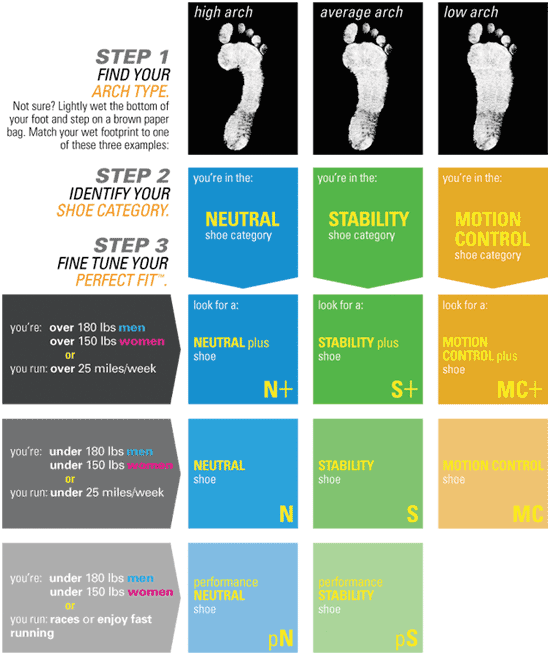Running doesn’t require a lot of equipment. In fact, that’s part of the beauty of running. You don’t really need anything special to do it, except for a pair of running shoes that perfectly fit your feet.
If you need to buy a new pair of shoes for jogging/ running, make sure you visit a reputable shoe/ sports store that specializes in running. Ask a salesperson to evaluate your gait and foot strike. Any good sports shop should provide this service. If they don’t, ask if they know of any stores in the area that do provide this service. It will make all the difference.
Choosing The Perfect Running Shoe
- Take the socks you’ll be running in, to wear with the shoes you will be trying on.
- Get fitted for running shoes at the end of the day when your feet are at their largest.
- Allow approximately half an inch between the end of your longest toe and the end of the shoe. You should be able to wiggle all toes.
- The shoe should not be tight across the front section of your foot. It should be as wide as possible to give your toes room, while not allowing your heel to slip.
- Experiment with the lacing of the shoe to get a proper fit.
- Try on both shoes. If one foot is larger than the other, as often happens, be sure to buy the larger size.
If the store is a good one and reputable, they may let you take the shoes outside for a test run. Don’t just walk on the carpeted or wooden flooring in the store. Make sure you can walk/ run on a hard/ concrete type surface.
Shoes should feel comfortable immediately. There shouldn’t be a “breaking in” phase. If you can feel the seams or stitching in the shoes, don’t buy them. If they feel a little uncomfortable when you try them on, it’s likely to only get worse with time.
Poorly fitting running shoes can cause rubbing, resulting in blisters, calluses or other injuries and obviously a decreased likelihood that you will run.
The Main Types of Running Shoes
Running shoes can be divided into three main categories (cushioned, stability and motion control). The right category is determined by your biomechanical needs:
Neutral Arch/ Normal pronator
This runner will land on the outside of the heel and roll a little inwards to absorb the impact. This foot is biomechanically efficient and does not require a motion control shoe.
Best Shoes: Stability shoes with moderate control features.
Flat Foot/ Over Pronator
If you are flat-footed, it often indicates an overpronated foot. This means that the foot strikes on the outside of the heel and rolls inwards (pronates) excessively. With time, this can cause different types of overuse injuries.
Best shoes: Motion control shoes or high stability shoes with firm mid soles and control features, which decrease the amount of overpronation. Avoid highly cushioned, highly curved shoes that lack stability features.
High Arch/ Under Pronator
Curved, highly arched feet and rigid feet are often supinated or underpronated. Since the foot does not pronate sufficiently, it generally is an ineffective shock-absorber.
Best shoes: Cushioned (or “neutral’) shoes with a lot of flexibility to encourage foot motion. Avoid motion control or stability shoes, as they reduce foot mobility.
Use the chart below to cross-reference your arch type with your weight/ running mileage to find a more specific shoe for a perfect fit.


